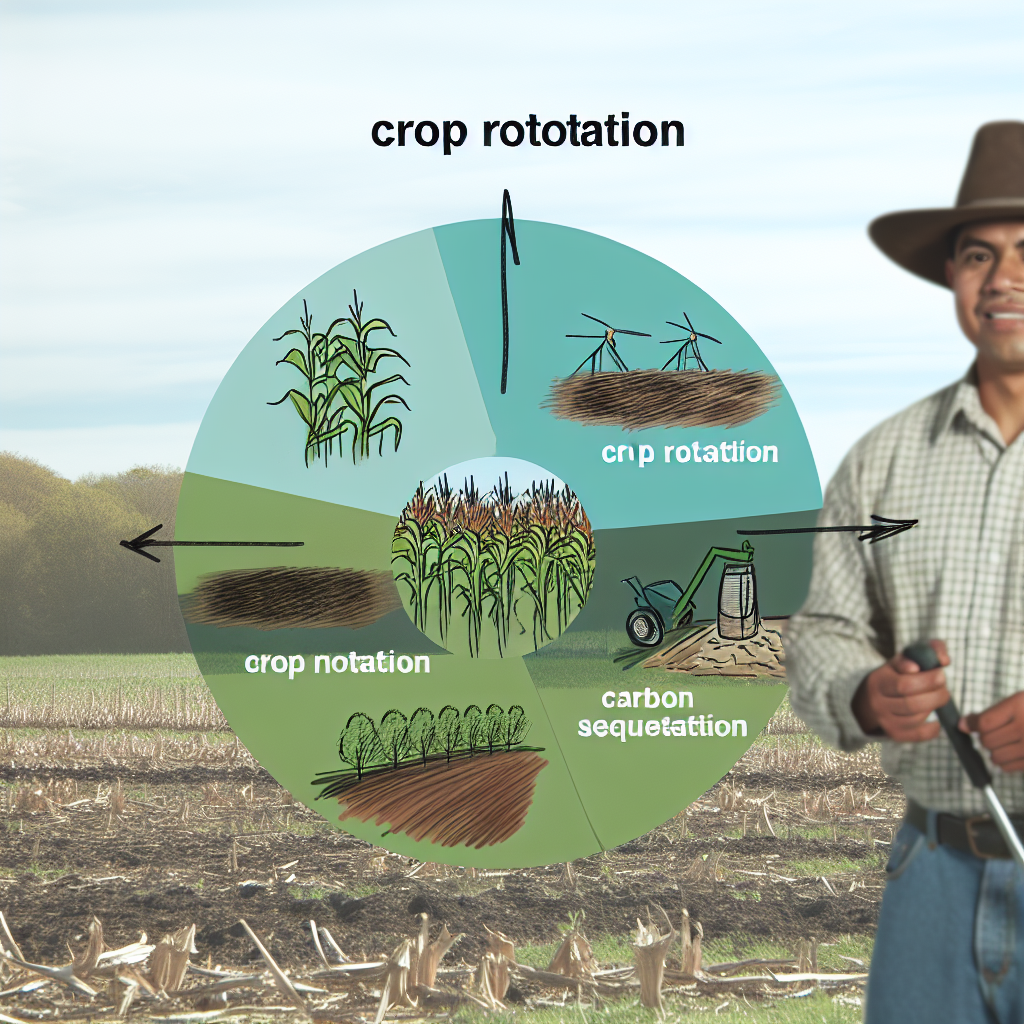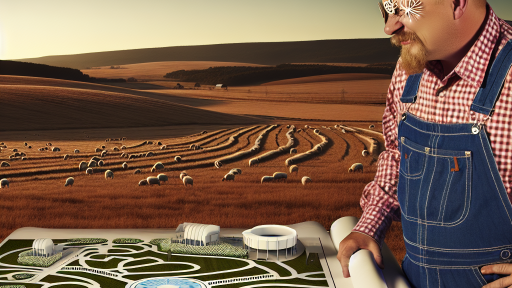Introduction to Crop Rotation
Definition of Crop Rotation
Crop rotation involves alternating crops in the same field over time.
This agricultural practice promotes soil health and fertility.
Farmers implement diverse crops to disrupt pest cycles.
Furthermore, it enhances nutrient management in the soil.
Importance of Crop Rotation
Crop rotation plays a vital role in sustainable agriculture.
It reduces the need for chemical fertilizers and pesticides.
Consequently, farmers experience lower production costs.
Additionally, crop rotation increases yields over time.
This practice promotes biodiversity within farming systems.
Environmental Benefits
One key benefit of crop rotation is improved carbon sequestration.
Utilizing different plant species enhances soil organic matter.
As a result, more carbon is stored in the soil.
This process helps mitigate climate change effects.
Moreover, it reduces soil erosion by maintaining ground cover.
Historical Context
Crop rotation has been practiced for centuries across various cultures.
Transform Your Agribusiness
Unlock your farm's potential with expert advice tailored to your needs. Get actionable steps that drive real results.
Get StartedAncient farmers recognized the benefits of rotating crops.
Historical records show that crop rotation improved yields significantly.
As a result, this technique became standard in many agricultural societies.
Understanding Carbon Sequestration
Mechanisms of Carbon Sequestration
Carbon sequestration involves capturing carbon dioxide from the atmosphere.
Plants play a critical role in this process through photosynthesis.
During photosynthesis, they absorb carbon dioxide and convert it into biomass.
Soils also contribute by storing carbon in organic matter.
Additionally, certain agricultural practices enhance soil carbon storage.
Moreover, carbon can be sequestered in forests, grasslands, and wetlands.
These ecosystems act as significant carbon sinks.
Thus, diverse habitats boost our capacity to capture carbon effectively.
Benefits of Carbon Sequestration
Carbon sequestration offers numerous environmental benefits.
First, it helps mitigate climate change by reducing greenhouse gases.
Second, it improves soil health through enhanced organic matter.
This practice also promotes agricultural productivity and sustainability.
Furthermore, healthy ecosystems support biodiversity.
Carbon sequestration contributes to better air and water quality.
Crops grown in enriched soils require fewer chemical fertilizers.
Overall, these practices lead to increased resilience against climate impacts.
Implementing Carbon Sequestration Strategies
Farmers can adopt various strategies to enhance carbon sequestration.
Cover cropping is one effective method.
This technique protects soil and adds organic matter when crops are not grown.
Crop rotation also improves soil structure and nutrient availability.
Additionally, reduced tillage preserves existing soil carbon.
Showcase Your Farming Business
Publish your professional farming services profile on our blog for a one-time fee of $200 and reach a dedicated audience of farmers and agribusiness owners.
Publish Your ProfileAgroforestry integrates trees and shrubs into farming systems.
This practice further enhances carbon storage in both soil and biomass.
Education and training for farmers can increase participation in these practices.
Supporting local initiatives can foster community involvement in carbon management.
The Role of Crop Rotation in Enhancing Soil Health
Improving Nutrient Cycling
Crop rotation significantly enhances nutrient cycling in the soil.
Diverse crops contribute various nutrients to the soil ecosystem.
For instance, legumes fix nitrogen, enriching the soil for future crops.
This practice reduces the need for synthetic fertilizers over time.
Breaking Pest and Disease Cycles
Crop rotation disrupts the life cycles of pests and diseases.
Changing crops each season prevents pests from establishing populations.
Consequently, farmers experience fewer outbreaks of plant diseases.
Such an approach promotes the overall health of the crops.
Enhancing Soil Structure
Soil structure improves with diverse root systems from rotated crops.
These systems create channels that allow better water infiltration.
As a result, soil erosion decreases, and overall soil health improves.
In the long run, this practice builds resiliency in farming systems.
Increasing Organic Matter
Incorporating cover crops into rotations increases organic matter.
These crops add biomass, which eventually decomposes in the soil.
Higher organic matter enhances moisture retention and microbial activity.
This process contributes to healthier and more productive soils.
Providing Environmental Benefits
Crop rotation offers significant environmental benefits.
It enhances biodiversity, supporting various organisms in the ecosystem.
Moreover, it can increase carbon sequestration in the soil.
As such, it plays a role in combating climate change effects.
Gain More Insights: Sustainable Farm Layout Techniques And Best Practices
Evaluating Different Crop Rotation Strategies for Carbon Sequestration
Introduction to Crop Rotation
Crop rotation is an essential practice in sustainable agriculture.
This method involves alternating the types of crops grown in specific fields.
It helps to enhance soil health and boost agricultural productivity.
Moreover, crop rotation can significantly aid in carbon sequestration.
Benefits of Crop Rotation
Crop rotation offers numerous environmental and economic benefits.
It increases soil organic matter over time.
This process enhances the soil’s ability to store carbon.
Additionally, it reduces the risk of crop diseases and pest infestations.
Farmers can enjoy better yields and reduced input costs.
Types of Crop Rotation Strategies
Different strategies can be adopted for effective crop rotation.
One common approach is the three-field system.
In this system, farmers rotate among three different crops annually.
This rotation allows for one field to rest and promote soil recovery.
Cover Cropping
Cover cropping is another effective strategy.
This method involves planting crops that are not harvested.
Showcase Your Farming Business
Publish your professional farming services profile on our blog for a one-time fee of $200 and reach a dedicated audience of farmers and agribusiness owners.
Publish Your ProfileInstead, these crops improve soil structure and enrich nutrients.
Cover crops can capture carbon dioxide from the atmosphere.
Legume Rotation
Integrating legumes into crop rotations can enhance nitrogen fixation.
This addition reduces the need for synthetic fertilizers.
Consequently, the reduction in fertilizers decreases soil emissions.
Evaluating Crop Rotation Practices
Evaluating the effectiveness of crop rotation is crucial.
Farmers should assess soil health and carbon levels annually.
Additionally, they can monitor yields and pest control mechanisms.
Such evaluation helps in refining crop rotation practices.
Regional Considerations and Adaptations
Crop rotation strategies may vary based on regional climates.
Farmers should consider local soil types and weather patterns.
This information aids in selecting the most suitable crops.
Understanding regional biodiversity can also inform better practices.
Future Directions in Crop Rotation Research
Future research should focus on optimizing crop rotation techniques.
This includes integrating technology for soil monitoring.
Additionally, studies should explore the synergy between different crops.
Innovative approaches can improve carbon sequestration efforts.
Discover More: No-Till Farming To Enhance Soil Regeneration
Comparative Analysis of Conventional vs. Sustainable Agriculture Practices
Defining Conventional Agriculture
Conventional agriculture focuses on maximizing yields using synthetic inputs.
This method relies heavily on chemical fertilizers and pesticides.
Farmers typically grow monocultures of cash crops.
Conventional practices often lead to soil degradation over time.
Water usage can be inefficient and environmentally damaging.
Exploring Sustainable Agriculture
Sustainable agriculture promotes practices that protect the environment.
It emphasizes biodiversity and crop rotation for improved yield stability.
This method minimizes the use of chemicals and synthetics.
Farmers use organic fertilizers to enrich the soil naturally.
Moreover, it encourages the preservation of water resources.
Key Differences in Practices
- Conventional agriculture uses synthetic fertilizers while sustainable agriculture prefers organic inputs.
- Monoculture is a common practice in conventional farming, contrasting with crop rotation in sustainable methods.
- Sustainable practices aim to minimize soil erosion, unlike conventional methods that may worsen it.
- Water conservation is crucial in sustainable agriculture, whereas conventional farming sometimes leads to overuse.
- Conventional farming often prioritizes short-term yields over long-term health, while sustainable practices do the opposite.
Impact on Carbon Sequestration
Conventional agriculture typically results in higher carbon emissions.
This occurs due to soil disturbance and synthetic chemical use.
In contrast, sustainable practices enhance carbon sequestration.
Incorporating cover crops and agroforestry significantly boosts soil carbon levels.
Furthermore, healthy soil can store more carbon, benefiting the planet.
Long-Term Viability
Conventional farming strategies often undermine soil health over time.
This can lead to reduced productivity and increased erosion.
Sustainable agriculture maintains soil health, promoting resilience.
By fostering biodiversity, sustainable methods sustain long-term crop yields.
Adopting sustainable practices proves crucial as climate challenges intensify.
Delve into the Subject: Soil Microbes And Their Role In Regeneration

Case Studies: Successful Implementation of Crop Rotation for Carbon Sequestration
Introduction to Case Studies
Case studies provide valuable insights into successful crop rotation practices.
Showcase Your Farming Business
Publish your professional farming services profile on our blog for a one-time fee of $200 and reach a dedicated audience of farmers and agribusiness owners.
Publish Your ProfileThey demonstrate the potential of crop rotation for enhancing carbon sequestration.
Several farmers and organizations have achieved notable success in this area.
Example: Green Acres Farm
Green Acres Farm, located in Illinois, transformed its farming practices.
By implementing a three-year crop rotation system, they increased soil carbon stocks.
This system included corn, soybeans, and cover crops.
As a result, soil organic matter improved significantly.
Results Achieved
After five years, Green Acres reported a 25% increase in soil organic carbon.
This improvement enhanced soil fertility and crop yields.
Additionally, it reduced carbon dioxide emissions by 18 tons annually.
Example: Willow Creek Family Farms
Willow Creek Family Farms in Nebraska adopted diverse crop rotation practices.
The farm rotated corn, wheat, and legumes every year.
This approach helped enhance soil structure and moisture retention.
Consequently, the farm saw a 30% reduction in irrigation needs.
Environmental Impact
Moreover, this method reduced soil erosion and nutrient runoff.
Farmers noticed healthier ecosystems surrounding their fields.
This resulted in increased biodiversity on their land.
Example: Sunny Meadows Collective
Sunny Meadows Collective in Oregon implemented crop rotation with agroforestry techniques.
They integrated fruit trees and nitrogen-fixing plants into their rotation.
This innovation not only sequestered carbon but also provided additional income.
Farmers experienced a 20% increase in overall farm profitability.
Long-Term Sustainability
This practice promoted long-term sustainability and resilience against climate change.
Furthermore, it attracted new customers interested in sustainable produce.
The collective has become a model for other local farms.
Importance of Crop Rotation
These case studies highlight the effectiveness of crop rotation for carbon sequestration.
They underscore the importance of innovative practices in sustainable agriculture.
Farmers worldwide can learn from these successes to adopt similar strategies.
Find Out More: Maximizing Soil Health with Effective Crop Rotation
Challenges and Limitations of Crop Rotation in Carbon Management
Complexity of Implementation
Crop rotation can be complicated to implement effectively.
Farmers must understand soil types and crop compatibility.
This knowledge varies significantly across different regions.
Consequently, effective rotation strategies may differ from one farm to another.
Economic Considerations
Economic factors often hinder the adoption of crop rotation.
Farmers may face financial constraints when switching crops.
They rely on market trends, which can be unpredictable.
Additionally, the costs of seeds and equipment can accumulate quickly.
Time and Labor Requirements
Crop rotation requires significant time and labor investments.
Farmers need to plan and manage multiple crops each season.
This planning can take away from other critical farm operations.
Consequently, some farmers may prioritize easier, single-crop systems.
Knowledge Gaps
There are often knowledge gaps regarding crop rotation benefits.
Showcase Your Farming Business
Publish your professional farming services profile on our blog for a one-time fee of $200 and reach a dedicated audience of farmers and agribusiness owners.
Publish Your ProfileMany farmers are unaware of its advantages for soil health.
This lack of information can perpetuate traditional farming practices.
Training and educational programs can help close these gaps.
Market Pressures
Market demands can force farmers to stick with monocultures.
High productivity from single crop systems often attracts better profits.
Consequently, the incentives to rotate crops may diminish significantly.
This reliance on high-demand crops can limit diversity on farms.
Environmental Factors
Environmental conditions play a crucial role in crop rotation success.
Climate change can alter expected crop yields and suitability.
For instance, drought or flooding can impair specific rotation patterns.
Farmers need adaptive strategies to respond to changing environmental conditions.
Future Directions: Integrating Technology in Crop Rotation for Better Carbon Storage
Current Technological Advances
Farmers increasingly rely on precision agriculture tools.
These tools provide detailed data about soil health and moisture levels.
Farm management software aids in planning crop rotations effectively.
Moreover, satellite imagery offers insights into crop growth patterns.
Innovative Techniques for Carbon Sequestration
Intercropping techniques maximize land use efficiency.
This method enhances carbon capture by incorporating diverse species.
Cover crops play a significant role in preventing soil erosion.
They also contribute to soil health and carbon storage.
Data-Driven Decision Making
Data analytics enables farmers to make informed choices.
They can analyze past yield data to optimize crop rotation plans.
Weather modeling tools assist in predicting optimal planting times.
This leads to better resource allocation and enhanced yields.
Collaboration with Technology Companies
Agtech companies partner with farmers to innovate farming practices.
They develop tools tailored to individual farm needs.
Such collaborations can increase carbon sequestration efficiency.
They also promote sustainable farming practices across the industry.
Education and Training Opportunities
Farmers need training to adopt new technologies successfully.
Workshops on digital tools can enhance their skills and knowledge.
Online platforms offer courses on sustainable farming techniques.
Such resources empower farmers to integrate technology effectively.
Additional Resources
Opportunities and Challenges Associated with “Carbon Farming” for …
Soil Health and Carbon Sequestration in US Croplands: A Policy …




